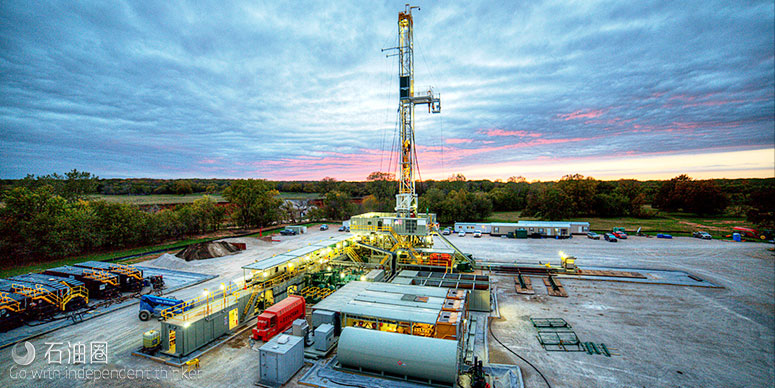In a bid to increase drilling efficiency in challenging reservoirs, which often push tools near the edge of their specification limits, Halliburton set out to create a more robust version of its rotary steerable system (RSS).
The new Geo-Pilot Duro RSS, part of the company’s Geo-Pilot platform, is intended for harsh environments where there might be a high level of vibration, resulting in stick-slip situations.
It is also intended for situations where there is a need for high lost circulation material (LCM) concentrations to address formation instabilities, or for conditions that result in fluid losses.
“It’s more robust than what’s been available in the past,” says Christian Menger, Halliburton’s global rotary steerable system product manager.
The tool is meant to overcome limitations such as tool durability, over-gauge and tortuous wellbores, and restricted flow-by areas, while offering improved steering accuracy and capacity for a high concentration of LCM.
According to the service company, the point-the-bit RSS does not rely on the formation to geosteer, which is advantageous in soft and unconsolidated formations.
It uses proportional steering, which allows 3D directional control with continuous drill string rotation. The system uses an internal drive shaft that is deflected using an eccentric cam system to point the drillbit through a focal bearing.
Externally, the tool features a slowly rotating reference housing decoupled from the drill string to help prevent formation damage. A reference stabilizer on the upper end of the reference housing uses reference disks to provide accurate tool-face control relative to the wellbore.
According to Menger, with a point-the-bit RSS, drill string dynamics, vibration and stick-slip do not affect tool-face control. A lower stabilizer also sits on the lower end of the reference housing.
The drillbit, lower stabilizer and reference stabilizer define the three-point steering geometry required for directional control.
“The Geo-Pilot platform is the only rotary steerable system in the industry where the second and third contact points of the steering geometry are decoupled from the drill string,” he says.
“This causes significantly less formation damage, especially when drilling through brittle or highly unconsolidated formations. In systems where these contact points rotate at full drill string speed, they have a tendency to ‘machine’ away the formation, thereby opening up the hole.”
An inline stabilizer runs above the RSS with a gauge larger or equivalent to the reference and lower stabilizers. The inline stabilizer removes hole restrictions when tripping out.
Extended range
Compared to the original Geo-Pilot platform, Menger says, the Geo-Pilot Duro introduces improvements that include a substantially increased flow-by area, ruggedised electronics assemblies, bearings, and seal components, and an extended operating range for rotary speeds, LCM, and shock and vibration.
The increased flow-by area allows faster casing shoe drilling, higher tripping speeds in and out of hole, and higher rates of penetration while drilling.
Eddison Fu, a marketing specialist at Halliburton’s Sperry Drilling business, says the ruggedised Duro system “handles shock and vibration and drilling parameters that traditional RSSs can’t handle. Its unmatched LCM tolerance improves drilling efficiency in which you can cure mud losses and then continue drilling without having to trip out.”
Other enhancements include an improved RPM and wider operating range along with a self-cleaning reference stabilizer. Flow ports make the assembly self-cleaning and prevent the accumulation of cuttings.
The improvements, Menger says, translate into reduced drill out times, higher penetration rates and increased tripping speed, improved well placement, and stick-slip tolerance.
The increased tripping speed, he notes, is particularly important for extended-reach and deep-water environments where it is expensive to trip out of the hole.
In conjunction with the Geo-Pilot Duro RSS, Halliburton is offering enhanced bottomhole assemblies (BHAs) to ensure the BHAs match the RSS’s specifications.
Menger says the system can be matched with measurement and logging while-drilling solutions so the rotary steerable BHA can have LCM concentration limited only by the drillbit nozzles.
A range of LCMs can be pumped through the Geo-Pilot Duro BHA at high concentrations to quickly cure formation losses without affecting the tool functionality, he adds.
Losses are cured more quickly and drilling can resume without changing the BHA — a capability, he says, that sets Halliburton’s system apart from other commercially available systems.
Development
Halliburton began developing Geo-Pilot Duro about four years ago in a bid to address challenging drilling conditions that require higher shock and vibration tolerance as well as faster rotation speeds.
“Development included a lot of simulation work” and sub-assembly testing, Menger notes.
The Duro comes with roughly 30 mechanical upgrades intended to improve internal robustness. Upgrades targeted seal and bearing assemblies, electronic ports and internal torque transmission, to name a few.
Menger says field testing in Malaysia revealed a 50% reduction in the time to drill casing shoes because of improved drilling efficiency.
“We’ve seen about a 30% improvement in shoe-to-shoe drilling time on average,” he says, noting the improvements are application specific and depend on the challenges of the drilling environment.
Field testing in Brazil’s pre-salt deep-water region showed rates of penetration exceeding those for offset wells.
“In Norway, the extended shock and vibration tolerance has been demonstrated in multiple applications where the well plan was successfully completed ahead of time despite challenging drilling conditions with high levels of shock and vibration,” Menger says.
“In offshore drilling operations, LCM concentrations up to 200 (pounds per barrel) including cement have been pumped through the BHA to quickly cure formation losses. Drilling operations resumed thereafter with no impact on tool operations.”
Halliburton commercialised Geo-Pilot Duro 9600 in November 2016 for hole sizes of 12 1/4 inches and larger.
The service company is testing a variant of the 9600 that has a torque rating of 55,000 foot pounds and is aimed at the deep-water pre-salt drilling market.
The company is also testing two other sizes, the 7600 for 8.5 and 8.75 inch holes, and the 5200 for the slimline market. “This covers the RSS drilling needs at the moment,” Menger says.

 石油圈
石油圈
